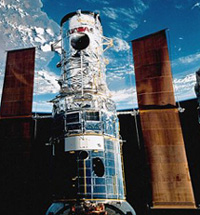The Hubble telescope being repaired.
Click on image for full size
NASA
NASA to Replace Hubble Telescope Instrument - Just BeCOS...
News story originally written on August 18, 1997
Well not exactly just because. NASA has chosen to include the COS instrument on the Hubble Space Telescope because it will help astronomers study how
stars were formed billions of years ago. It will also help astronomers find out how the first elements were formed. COS stands for Cosmic Origins Spectrograph.
The instrument will be put onboard the Hubble telescope in 2002. The COS is expected to be a very important HST instrument into the first decade of the next century. The estimated cost of this state-of-the-art spectrograph is $25 million.
The Hubble Space Telescope is a 2.4 meter reflecting telescope. It continues to make astronomical observations while in low-Earth orbit.
You might also be interested in:

It was another exciting and frustrating year for the space science program. It seemed that every step forward led to one backwards. Either way, NASA led the way to a great century of discovery. Unfortunately,
...more
The Space Shuttle Discovery lifted off from Kennedy Space Center on October 29th at 2:19 p.m. EST. The weather was great as Discovery took 8 1/2 minutes to reach orbit. This was the United States' 123rd
...more
A moon was discovered orbiting the asteroid, Eugenia. This is only the second time in history that a satellite has been seen circling an asteroid. A special mirror allowed scientists to find the moon
...more
Will Russia ever put the service module for the International Space Station in space? NASA officials want an answer from the Russian government. The necessary service module is currently waiting to be
...more
A coronal mass ejection (CME) happened on the Sun early last month. The material that was thrown out from this explosion passed the ACE spacecraft. The SWICS instrument on ACE has produced a new and very
...more
J.S. Maini of the Canadian Forest Service called forests the "heart and lungs of the world." This is because forests filter air and water pollution, absorb carbon dioxide, release oxygen, and maintain
...more
In late April through mid-May 2002, all five naked-eye planets are visible at the same time in the night sky! This is includes Mercury which is generally very hard to see. You won't want to miss this!
...more















